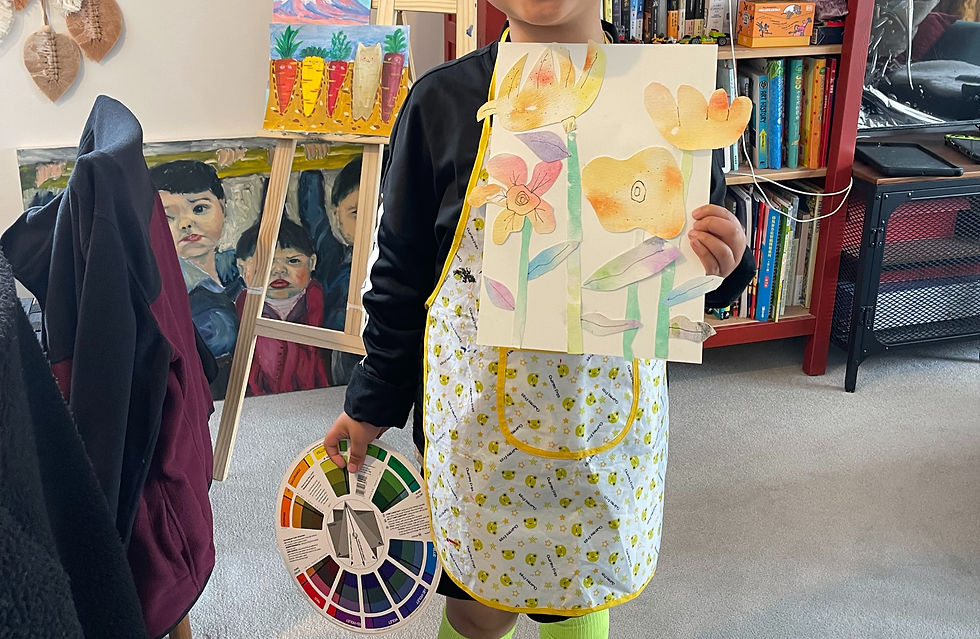Cannock Art Teacher Dairy: The Child Who Painted Outside the Lines
- zoehohk
- May 26
- 3 min read

Cannock Art Teacher Dairy: The Child Who Painted Outside the Lines
The Unexpected Artist in the Room
As an art teacher, I’ve met many children—some quiet, some chatty, some who love to copy my drawings line by line, and others who like to do things their own way. But every now and then, a student walks in who completely shifts how I see my role as a teacher.
One of those students came into my class not too long ago. From the beginning, I could tell he was different. Not in a “difficult” way, but in a way that made me curious. He didn’t like following instructions. He didn’t wait for step-by-step guidance. While the rest of the class watched me carefully and tried to make their work look just like mine, he was already busy mixing colours I hadn’t taught yet, trying out brush techniques I’d never shown.
At first, I wasn’t sure how to reach him. But very quickly, I realised—I wasn’t supposed to reach him in the usual way. I was meant to watch him, learn from him, and most importantly, give him space.

His Own Way, His Own World
One day, I taught the class a basic watercolour blending technique. I showed them how to use water to soften edges and mix gentle shades. The class nodded and copied as best they could.
Except for him.
He picked up colours that didn’t seem to "match." He splashed and layered with boldness, creating new textures and shapes. He didn’t ask for help. He didn’t seem worried about getting it “right.” And when I looked at his final piece, I was genuinely surprised.
It was beautiful.
Not perfect, not what I’d demonstrated—but alive, emotional, and full of personality. It had depth that went beyond the lesson. In that moment, I saw something I hadn’t expected: his mind was wired for discovery, not repetition.

The Strange-Shaped Buildings
Another time, I asked the class to draw buildings. Most children drew neat squares, rectangles, rooftops, windows in rows. He drew buildings that twisted and leaned, with odd shapes and slanted lines. They looked like something from a dream.
I asked gently, “Why did you draw them like that?”
He looked at me, completely serious, and said,"Because the architect forgot how to build a normal one, so he just built it this way."
I feel warm and touching. This is what exactly creativity! Because that answer—that one sentence—said so much. He wasn’t just drawing. He was telling a story. A story about mistakes, about freedom, about imagination that doesn’t need permission.
Behind His Eyes
Later, during a quiet moment, he told me something that stayed with me.
"I don’t have any friends at school," he said, eyes focused on his painting. "I’m a bit weird."
My heart broke a little. I could feel the loneliness in his voice, even though he said it as if it didn’t matter. But I knew it did.
Being different is hard when you're young. Not every child understands you. Not every adult knows how to respond to you. But in that art room, I saw something so special in him—something I wanted him to see in himself.
And I thought: if art can give him even a small moment of pride, of connection, of belonging—then that’s what I’m here for.

What He Taught Me
I used to think teaching was about showing children how to do things the “right” way.
But this student reminded me that sometimes, our job isn’t to lead—it’s to follow. To watch, to listen, and to let go of the rules when the rules don’t fit.
He taught me that being “different” isn’t a weakness—it’s often a sign of deep, unfiltered creativity. He didn’t need to be corrected. He needed to be understood.
A Note to Parents and Teachers
If you have a child who doesn’t follow instructions, who seems lost in their own world, who colours outside the lines—don’t rush to fix them. Watch them. Give them space. Ask questions. They might be telling you something beautiful in a language we sometimes forget to listen to.
They might be building crooked buildings for all the right reasons.
The Brilliance Behind the Brush
That little boy still comes to class. He still experiments. Still surprises me. And while he may not have many friends at school, I hope that here—in our little art room—he knows he is seen, celebrated, and safe to be himself.
And maybe one day, he’ll look back and remember the place where he was free to imagine the impossible—and know that his way of seeing the world was never wrong. It was just wonderfully his own.
Meow Meow Art Lab


Comments